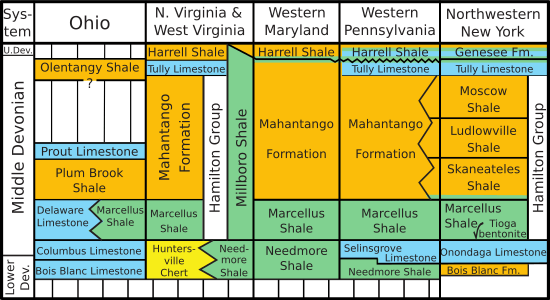Hamilton Group facts for kids
Quick facts for kids Hamilton Group orMillboro Shale Stratigraphic range: Eifelian - Famennian |
|
|---|---|
| Type | Geological unit |
| Sub-units | Mahantango Formation Marcellus Formation |
| Underlies | Brallier Formation and Harrell Shale |
| Overlies | Marcellus Formation |
| Thickness | up to 2,500 feet (800 m) |
| Lithology | |
| Primary | Shale |
| Other | Limestone, Siltstone, Sandstone, Claystone |
| Location | |
| Region | Appalachian Basin of eastern North America |
| Extent | Maryland, New York, Pennsylvania, Virginia, and West Virginia |
| Type section | |
| Named for | Hamilton, New York |
| Named by | James Hall |
The Hamilton Group is a collection of rock layers from the Devonian period. This period was about 419 to 359 million years ago. These rock layers are found in the Appalachian region of the United States. You can find them in states like New York, Pennsylvania, Maryland, Ohio, West Virginia, and northwestern Virginia.
The Hamilton Group is mostly made of shale that formed in the ocean. It also contains some sandstone. Inside this group, there are two main rock formations. These are the Mahantango Formation and the Marcellus Shale. In parts of southwestern Virginia, these two formations are hard to tell apart. So, the Hamilton Group there is often called the Millboro Shale or Millboro Formation. The group gets its name from the village of Hamilton, New York. These rocks are the oldest layers that contain natural gas from the Devonian period.

Contents
Understanding Rock Layers
Geologists study rock layers to understand Earth's history. This is called stratigraphy. The Hamilton Group is made of different layers of rock.
The Mahantango Formation
The Mahantango Formation is one part of the Hamilton Group. It has layers of gray, dark gray, brown, and olive-colored shale. It also contains siltstone and very fine-grained sandstone or claystone. These rocks often hold marine fossils, which are remains of ancient sea creatures. The top layers of the Mahantango Formation are especially rich in these fossils.
The Marcellus Shale
Below the Mahantango Formation is the Marcellus Shale. This rock is usually gray-black to black. It is thinly layered and contains pyrite, which is also known as "fool's gold." It also has carbon and round mineral clumps called siderite concretions. This shale also contains some marine fossils.
How Thick Are These Rocks?
In Pennsylvania, the Hamilton Group is about 970 feet thick. In New York State, its thickness changes a lot. Near Lake Erie, it is about 250 feet thick. But in Ulster and Greene counties, it can be over 2,500 feet thick. These rocks can be found from the surface down to 8,000 feet deep in places like Sullivan County.
Other Formations in the Hamilton Group
In New York, the Hamilton Group includes several formations. These are the Marcellus, Skaneateles, Ludlowville, and Moscow Formations. They are separated by layers of limestone like the Stafford, Centerfield, and Tichenor limestones. In Canada, near Ontario, the Hamilton Group also has different formations. These include the Bell, Rockport Quarry, Arkona, Hungry Hollow, Widder, and Ipperwash formations.
The Mahantango Formation itself has smaller parts called members. These include the Tully argillaceous limestone, Sherman Ridge, and Montebello sandstone. In Maryland, the Mahantango Formation ranges from 600 to 1,200 feet thick. In central Pennsylvania, it is about 1,000 feet thick.
The Marcellus Formation also has a local limestone layer called the Purcell Member. It also has a special ash layer called Tioga bentonite at its base in eastern Pennsylvania. In Maryland, the Marcellus Formation is between 250 and 500 feet thick. In central Pennsylvania, it is only about 70 feet thick.
Long ago, the Hamilton Group, along with the Tioga Metabentonite Bed and Needmore Shale, was sometimes called the Romney Formation.
- The Geneseo Shale is a dark gray to black shale found above the Tully Limestone.
- The Tully Limestone is a rock layer that formed in shallow ocean water.
- The Moscow Formation has gray to black shales mixed with limestones. It often shows signs of ancient animal activity.
When Did These Rocks Form?
Scientists use "relative age dating" to figure out how old rocks are compared to other rocks. The Hamilton Group formed during the middle and lower parts of the Devonian period.
In Maryland, the Hamilton Group sits on top of the Tioga Metabentonite. This is a thin layer of shale. Below that is the Needmore Shale. In other areas, the Needmore Shale might be replaced by similar rocks. These include limestone and shale from the Onondaga Formation or a rock called Huntersville Chert.
The Hamilton Group is found below the Brallier Formation in its southern areas. Further north, it is covered by the Tully Limestone. Some scientists consider the Tully Limestone to be a part of the Mahantango Formation. The Tully Limestone is then covered by the dark Harrell Shale. In 2012, scientists Read and Erikson said that the Hamilton Group in Virginia dates from the Eifelian to Famennian ages. These are specific time periods within the Devonian.
What Are These Rocks Used For?
The Hamilton Group rocks are useful for many things. They are a good source of material for building roads. They can also be used for riprap, which are large stones used to protect shorelines. People also use them as building stones. Locally, the shale is used as a type of gravel and for filling in land.

